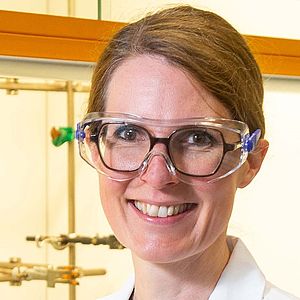
Material Worlds and Sustainability
Fascinating topics from modern natural and life sciences, dealing with materials and the forces present in matter: Researchers at the University of Regensburg (UR) seek solutions to the key sustainability challenges facing current and future societies. DFG-funded Collaborative Research Centers/Transregios (CRC/TRR) and lighthouse projects, financed by the High-Tech Agenda Bavaria, conduct pioneering interdisciplinary research projects. Various early career research groups and doctoral programs provide training to the next generation of scientists.
Projects and programs are interlinking UR’s Faculties of Biology and Preclinical Medicine, Chemistry and Pharmacy, and Physics. Scholars dealing with the quantum world are looking forward to a dedicated large-scale research facility opening in 2024: Regensburg’s new interdisciplinary Center for Ultrafast Nanoscopy - RUN is offering a complementary array of state-of-the-art ultrafast nanoscopy facilities: It will provide the researchers with insights into the incredibly fast motion of atoms, molecules, and electrons that yields the functions of new quantum materials, causes chemical reactions, and defines vital processes in cells.
© UR | Graphics: Astrid Riege
Exceptional Research @UR
The CRC 1277 "Emergent Relativistic Effects in Condensed Matter" focuses on novel classes of materials which have been identified in the past few years and might enable a paradigm shift for future electronics. The CRC is investigating the fundamental properties of these special electronic systems and the emergent relativistic effects they entail.
Moreover, the researchers’ common aim is to explore if and how the Dirac-like band structures and strong spin-orbit coupling in novel material classes and nanostructures can be exploited for future electronic concepts and lead to new, yet unforeseen functionalities. The objective is to uncover electronic, transport, magnetic and optical properties of a variety of such materials and systems.
Two lighthouse projects within the Munich Quantum Valley are
"Free-electron states as ultrafast probes for qubit dynamics in solid-state platforms": UR physicists aim at developing the prototype of an ultrafast transmission electron microscope that will be used to investigate the quantum dynamics of single qubits with highest spatial and temporal resolution.
"Quantum circuits with spin qubits and hybrid Josephson junctions": The project is carried out within the UR by four research groups of the Faculty of Physics and addresses cornerstones of possible future quantum computers: qubit processors and interfaces to hybrid quantum technologies.
The CRC/TRR 325 "Assembly Controlled Chemical Photocatalysis" is exploring photo-electro chemistry and represents a consortium of 15 principal investigators who run a total number of 18 collaborative projects in the field of light-induced reactions. It’s declared goal is traversing new frontiers in photocatalysis for organic synthesis by designed control of catalyst-substrate interactions.
Results of this research will enable a broader application of light-initiated chemical transformations as an essential tool for the selective and efficient synthesis of complex molecules in academic research and industrial production.
The DFG-funded Research Training Group (RTG) 2620 "Ion Pair Effects in Molecular Reactivity" strives to provide transferable concepts of ion pairs for the prediction and control of structures, reactivities and enantioselectivities.
At the same time, it focuses on excellent interdisciplinary graduate student education. So does the Doctoral Program 'Photo-Electro Catalysis' , funded by the Elite Network of Bavaria.
The German Research Foundation (DFG) is funding the Research Training Group (RTG) 2905 "Ultrafast Nanoscopy - from Single Particle Dynamics to Cooperative Processes" at the University of Regensburg (UR) for five years from April 2024 with a total of six million euros.
The RTG is located in the unique interdisciplinary environment of RUN, the Regensburg Center for Ultrafast Nanoscopy.
Twelve scientists from the Institute of Experimental and Applied Physics (Isabella Gierz, Franz Giessibl, Rupert Huber, John Lupton, Jascha Repp, and Sascha Schaefer), the Institute of Theoretical Physics (Ferdinand Evers, Milena Grifoni, Klaus Richter, and Jan Wilhelm), the Institute of Biochemistry, Genetics, and Microbiology (Dina Grohmann), as well as the Institute of Biophysics and Physical Biochemistry (Christine Ziegler) lead the interdisciplinary RTG.
#notabene
Grants
ERC Synergy Grant Christine Ziegler "HYDROSENSING", 2023
ERC Synergy Grant Rupert Huber/Ulrich Hoefer "Orbital Cinema", 2022
ERC Synergy Grant Jascha Repp "MolDAM", 2020
ERC Advanced Grant Dieter Weiss "ProMotion", 2017
ERC Consolidator Grant Robert Wolf "FunctionalP4", 2017
ERC Starting Grant Markus Jeschek "BiosenSAI", 2023
ERC Starting Grant Joshua Barham "HELIOS", 2022
ERC Starting Grant Isabella Gierz "DANCE", 2019
ERC Starting Grant Alexander Breder "ELDORADO", 2018
Klaus Richter "Many-Body Quantum Processes at the Edge of Chaos: From Non-Equilibrium Thermodynamics towards Quantum Gravity", 2021-2026
Burkhard König "Carbanions for synthesis by photoinduced sequential multi-electron transfer", 2018-2024
#illustratedscience
Complex energy surface created by Moiré effect in superimposed monoatomic layers, resulting in hexagonal rather than circular cyclotron motion of electrons in magnetic field.
Courtesy of Klaus Richter and Ming-Hao Liu @ Ming-Hao Liu, Tainan, Taiwan
The Quantum World in Motion
The Physicist Rupert Huber Strives for a New Level of Understanding of the Nanocosmos
Illustration © Orbital Cinema, ERC Snyergy Grant Project by Rupert Huber and Ulrich Hoefer / https://orbital-cinema.eu/
Reaching a New Level of Diagnostics
Developing a Novel Nanomaterial-Based Biosensor


















